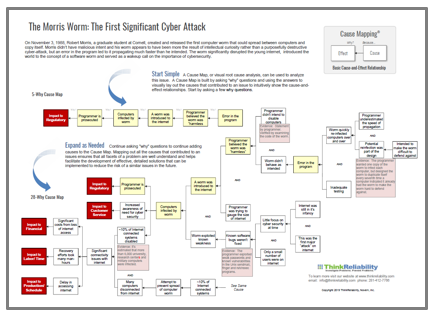On November 3, 1988, Robert Morris, a graduate student at Cornell, created and released the first computer worm that could spread between computers and copy itself. Morris didn’t have malicious intent and his worm appears to have been more the result of intellectual curiosity rather than a purposefully destructive cyber-attack, but an error in the program led to it propagating much faster than he intended. The worm significantly disrupted the young internet, introduced the world to the concept of a software worm and served as a wakeup call on the importance of cybersecurity.
Build a Cause Map
A Cause Map, a visual root cause analysis, can be used to create a root cause analysis case study and analyze this incident. A Cause Map is built by asking “why” questions and using the answers to visually lay out the causes that contributed to an issue to intuitively show the cause-and-effect relationships. Mapping out all the causes that contributed to an issues ensures that all facets of a problem are well understood and helps facilitate the development of effective, detailed solutions that can be implemented to reduce the risk of a similar issues in the future.
Known flaws
To create his worm, Morris exploited known software bugs and weak passwords that no one had worried about enough to fix. At the time the Morris worm was released, the internet was in its infancy and only used by academics. There was no commercial traffic on the internet, and websites did not exist. Only a small, elite group had access to the internet, so concerns about cybersecurity hadn’t really come up.
What went wrong
Morris was trying to build a harmless worm to highlight security flaws, but an error in the program led to the worm causing a significant amount of disruption. The worm was intended to infect each computer one time, but the worm was designed to duplicate itself every seventh time a computer indicated it had already been infected to make the worm more difficult to remove. The problem was that the speed of propagation was underestimated. Once released, the worm quickly reinfected computers over and over again until they were unable to function, and the internet came crashing down.
The worm did more damage than Morris had expected and once he realized what he had done, he asked a colleague to anonymously apologize for the worm and explain how to update computers to prevent it from spreading. But the warning came too late to prevent massive disruption.
Impacts of the Morris Worm
In the short term, The Morris worm created a mess that took many computer experts days to clean up. One of the lasting impacts from the Morris worm that is hard to quantify, but is the most significant consequence of this incident, is the impact on cybersecurity. If the first “hacker” had malicious intent and came a little later, it's likely that the damage would have been much more severe. The Morris worm highlighted the need to consider cybersecurity relatively early in the development of the internet.
The Morris worm also had a significant impact on its creator, Robert Morris, who became the first person to be indicted under the 1986 Computer Fraud and Abuse Act. He was hit with a $10,050 fine, 400 hours of community service and a three-year probation. After this initial hiccup, Morris went on to have a successful career and now works in the MIT Computer Science and Artificial Intelligence Laboratory.
Download a copy of our Cause Map of the incident.











